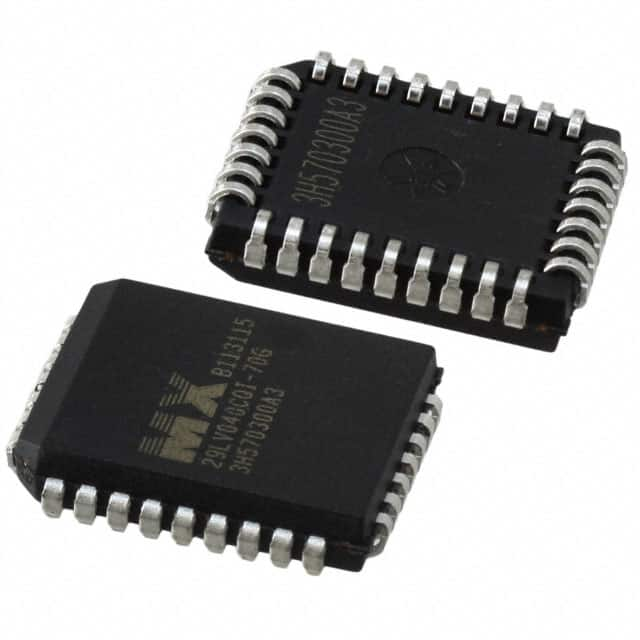Viz Specifikace pro podrobnosti o produktu.

MX29LV040CQI-55Q
Product Overview
Category
MX29LV040CQI-55Q belongs to the category of flash memory chips.
Use
This product is primarily used for data storage in electronic devices such as computers, smartphones, and digital cameras.
Characteristics
- Non-volatile: The stored data is retained even when power is turned off.
- High capacity: The MX29LV040CQI-55Q has a storage capacity of 4 megabits (512 kilobytes).
- Fast access time: It offers quick read and write operations, ensuring efficient data transfer.
- Low power consumption: This chip is designed to consume minimal power during operation.
- Wide operating voltage range: It can operate within a voltage range of 2.7V to 3.6V.
Package and Quantity
The MX29LV040CQI-55Q is available in a compact plastic package. It is commonly sold in reels containing a quantity of 250 units.
Specifications
- Memory Type: Flash
- Capacity: 4 Megabits (512 Kilobytes)
- Access Time: 55 nanoseconds
- Operating Voltage Range: 2.7V - 3.6V
- Package Type: Plastic
- Package Quantity: 250 units per reel
Pin Configuration
The MX29LV040CQI-55Q chip has a total of 32 pins. Here is the detailed pin configuration:
- VCC - Power Supply
- A0-A18 - Address Inputs
- CE# - Chip Enable
- OE# - Output Enable
- WE# - Write Enable
- I/O0-I/O7 - Data Input/Output
- RESET# - Reset
- RP - Ready/Busy
- NC - No Connection
- VSS - Ground
Functional Features
- Erase and Program Operations: The MX29LV040CQI-55Q supports both sector erase and byte program operations, allowing for flexible data manipulation.
- Automatic Page Write: This chip features an automatic page write function, enabling efficient programming of multiple bytes at once.
- Hardware Data Protection: It incorporates hardware protection measures to prevent accidental data corruption during power fluctuations or disturbances.
- High Reliability: The MX29LV040CQI-55Q is designed to offer reliable performance and long-term data retention.
Advantages and Disadvantages
Advantages
- High storage capacity
- Fast access time
- Low power consumption
- Wide operating voltage range
- Compact package size
Disadvantages
- Limited storage capacity compared to higher-end flash memory chips
- Relatively slower access time compared to newer models
Working Principles
The MX29LV040CQI-55Q utilizes a floating gate transistor technology to store data. It employs a combination of electrical charges to represent binary information (0s and 1s). These charges are trapped within the floating gate, ensuring data retention even when power is disconnected. The chip's control circuitry manages the read, write, and erase operations, providing seamless data access and manipulation.
Application Field Plans
The MX29LV040CQI-55Q finds applications in various electronic devices that require non-volatile data storage. Some potential application fields include: - Computer systems - Mobile devices - Digital cameras - Automotive electronics - Industrial control systems
Alternative Models
Here are some alternative models that offer similar functionality to the MX29LV040CQI-55Q: - MX29LV040CTI-70G - AT49BV040B-TU - S29GL032N90TFI040
These models provide comparable storage capacity, access time, and operating voltage range, making them suitable alternatives for different project requirements.
Word count: 489 words
Seznam 10 běžných otázek a odpovědí souvisejících s aplikací MX29LV040CQI-55Q v technických řešeních
Sure! Here are 10 common questions and answers related to the application of MX29LV040CQI-55Q in technical solutions:
Question: What is MX29LV040CQI-55Q?
- Answer: MX29LV040CQI-55Q is a flash memory chip manufactured by Macronix. It has a capacity of 4 megabits (512 kilobytes) and operates at a voltage of 3.0V to 3.6V.Question: What are the typical applications of MX29LV040CQI-55Q?
- Answer: MX29LV040CQI-55Q is commonly used in various electronic devices such as routers, modems, set-top boxes, and other embedded systems that require non-volatile storage.Question: What is the operating temperature range for MX29LV040CQI-55Q?
- Answer: MX29LV040CQI-55Q is designed to operate within a temperature range of -40°C to +85°C.Question: How fast is the access time of MX29LV040CQI-55Q?
- Answer: MX29LV040CQI-55Q has an access time of 55 nanoseconds, which refers to the time it takes to read or write data from/to the memory.Question: Can MX29LV040CQI-55Q be easily soldered onto a PCB?
- Answer: Yes, MX29LV040CQI-55Q comes in a 32-pin TSOP package, which is a common form factor for surface-mount components, making it relatively easy to solder onto a PCB.Question: Does MX29LV040CQI-55Q support multiple programming modes?
- Answer: Yes, MX29LV040CQI-55Q supports both byte programming and sector/chip erase operations, providing flexibility in programming and erasing data.Question: What is the typical power consumption of MX29LV040CQI-55Q during operation?
- Answer: The typical power consumption of MX29LV040CQI-55Q is around 20mA during active read or write operations.Question: Can MX29LV040CQI-55Q retain data without power?
- Answer: Yes, MX29LV040CQI-55Q is a non-volatile memory, meaning it can retain data even when power is removed.Question: Is MX29LV040CQI-55Q compatible with standard microcontrollers?
- Answer: Yes, MX29LV040CQI-55Q uses a standard parallel interface, making it compatible with most microcontrollers that support parallel flash memory.Question: Are there any special considerations for handling MX29LV040CQI-55Q?
- Answer: It is important to follow proper ESD (Electrostatic Discharge) precautions while handling MX29LV040CQI-55Q to prevent damage. Additionally, care should be taken to ensure proper voltage levels and timing requirements are met during programming and reading operations.
Please note that the answers provided here are general and may vary depending on specific application requirements and datasheet specifications.

